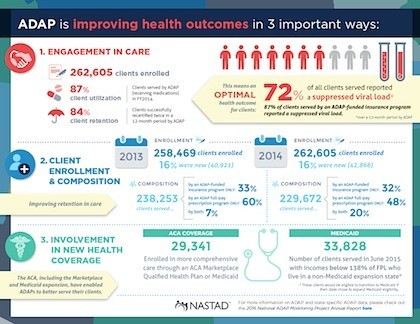An annual report on the AIDS Drug Assistance Program highlights three ways ADAP is improving health outcomes in the country. Published by the National Alliance of State and Territorial AIDS Directors (NASTAD) as part of its National ADAP Monitoring Project, the report tracks the budgets, changes and challenges facing the $2.24 billion program.
In addition to providing key data about ADAP, the report spells out how ADAP works with the Affordable Care Act (ACA, or Obamacare) to provide access to health insurance. The report notes:
- While the ACA has resulted in an unprecedented expansion of access to both private and public health insurance, the cost of insurance remains too high for many individuals, even with the availability of federal subsidies. The Ryan White Program allows states to use ADAP funds to purchase health insurance and pay insurance premiums, co-payments and/or deductibles for individuals eligible for ADAP, provided the insurance has comparable formulary benefits to that of the ADAP and is cost-effective to the ADAP.

3 ways ADAP improves health outcomes. Visit nastad.org to download a PDF.
An infographic accompanying the report lists three ways that ADAP improves health outcomes: engagement in care; client enrollment and composition; and involvement in new health coverage.
Now for some number-crunching. Below are a few of the figures found in the 2016 annual report:
- ADAPs served over 139,000 clients in June 2015, representing a 5 percent overall decrease from June 2014.
- Twenty ADAPs reported increases of 5 percent or more clients served between June 2014 and June 2015, while 16 reported decreases of 5 percent or more in the number of clients served between June 2014 and June 2015.
- Among the 20 ADAPs that reported increases in the number of clients served of 5 percent or more between June 2014 and June 2015, half of those are states in which Medicaid eligibility has not been expanded.
- Total ADAP drug expenditures were $130,921,720 in June 2015.
- The total ADAP budget increased by 1 percent between FY2014 and FY2015, reaching $2.24 billion.
- In FY2015, the federal ADAP earmark was $784 million.
- The earmark was one-quarter of the total ADAP budget in FY1996, the year it was created, rose to more than two-thirds (68 percent) of the budget in FY2000 and has most recently declined as a share of the overall budget to 35 percent in FY2015.
- The ADAP earmark itself increased in FY2015 by 0.3 percent from FY2014.
- Drug rebates accounted for $1.016 billion, or 45 percent of the overall ADAP budget in FY2015. This funding represents money that is paid to the state by manufacturers as a result of rebate claims based on drug purchases. This represents an increase of 6 percent from FY2014.
- State contributions accounted for $189.1 million, or 8 percent, of the overall ADAP budget in FY2015. This marks a decrease of 19 percent from FY2014.







Comments
Comments